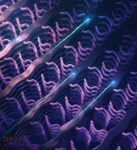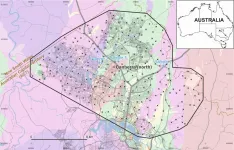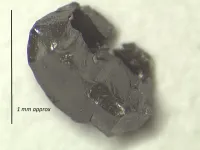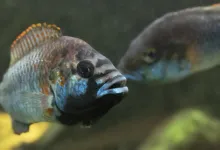Building a better biosensor polymer
2021-07-06
(Press-News.org) A new organic (carbon-based) semiconducting material has been developed that outperforms existing options for building the next generation of biosensors. An international research team led by KAUST is the first to overcome some critical challenges in developing this polymer.
Much research effort is currently expended into novel types of biosensors that interact directly with the body to detect key biochemicals and serve as indicators of health and disease.
"For a sensor to be compatible with the body, we need to use soft organic materials with mechanical properties that match those of biological tissues," says Rawad Hallani, a former research scientist in the KAUST team, who developed the polymer along with researchers at several universities in the U.S. and the U.K.
Hallani explains that the polymer is designed for use in devices called organic electrochemical transistors (OECTs). For these types of devices, the polymer should allow specific ions and biochemical compounds to permeate into the polymer and dope it, which in turn can modulate its electrochemical semiconducting properties. "The fluctuation in the electrochemical properties is what we are actually measuring as an output signal of the OECT," he says.
The team had to confront several chemical challenges because even minor changes in the polymer's structure can have a significant impact on performance. Many other research groups have tried to make this particular polymer, but the KAUST team is the first to succeed.
Their innovation is based on polymers called polythiophenes with chemical groups called glycols attached in precisely controlled positions. Learning how to control the locations of the glycol groups in ways not previously achieved was a key aspect of the breakthrough.
"Identifying the right polymer design to fit all the criteria that you are looking for is the tough part," says Hallani. "Sometimes what can optimize the performance of the material can negatively affect its stability, so we need to keep in mind the energetic as well as the electronic properties of the polymer."
Sophisticated computational chemistry modeling was used to help achieve the right design. The team was also aided by specialized x-ray scattering analysis and scanning tunneling electron microscopy to monitor the structure of their polymers. These techniques revealed how the location of the glycol groups affected the material's microstructure and electronic properties.
"We are excited by the progress Rawad made on the polymer synthesis, and we are now looking forward to testing our new polymer in specific biosensor devices." says Iain McCulloch of the KAUST team, who is also attached to the University of Oxford in the U.K.
McCulloch says that the research group is now trying to improve the stability of their polymers and the sensors built from them, as they move from laboratory demonstrations toward real world applications.
INFORMATION:
[Attachments] See images for this press release:

ELSE PRESS RELEASES FROM THIS DATE:
2021-07-06
Networks of ground-based sensors paired with airborne drones could give firefighters a critical edge when battling wildfires, KAUST researchers have found. The sensor/unmanned aerial vehicle (UAV) network could significantly shorten the time taken to detect a wildfire, giving firefighters a better chance to contain the fire before it grows too large to control.
Wildfire detection is currently performed mainly by satellite imaging and remote cameras, but these technologies can be impeded by cloudy weather and fires can grow to a considerable size before they are spotted. With the recent significant global ...
2021-07-06
The surprising results of a decade-long investigation by Alessandro Vezzosi and Agnese Sabato provide a strong basis for advancing a project researching Leonardo da Vinci's DNA.
Their extensive study, published by the journal "Human Evolution" (Pontecorboli Editore, Florence), documents with new certainty the continuous male line, from father to son, of the Da Vinci family (later Vinci), from progenitor Michele (born 1331) to grandson Leonardo (6th generation, born 1452) through to today -- 21 generations in all, including five family branches -- and identifies 14 living descendants.
The work fills gaps and corrects errors in previous genealogical research into Leonardo's family, while ...
2021-07-06
A new study shows how urbanisation has influenced anthropogenic CO2 and air pollutant emissions across all world regions, by making use of the latest developments in the Emissions Database for Global Atmospheric Research (EDGAR, https://edgar.jrc.ec.europa.eu/) developed by the Joint Research Centre of the European Commission. The results show that by 2015 urban centres were the source of a third of global anthropogenic greenhouse gases, and the majority of air pollutant emissions.
The authors, from institutions in France and Italy, used the EDGAR database to provide a country-to-global ...
2021-07-06
Researchers at Karolinska Institutet in Sweden publish new findings in the journal Cancer Discovery showing how pharmacological activation of the protein p53 boosts the immune response against tumours. The results can be of significance to the development of new combination therapies that will give more cancer patients access to immunotherapy.
Given its ability to react to damage to cellular DNA and the key part it is thought to play in preventing tumour growth, the protein p53 has been dubbed the "guardian of the genome". Half of all tumours have mutations in the gene that codes for the protein, and in many other tumours, p53 is disabled by another protein, MDM2.
It has long been known ...
2021-07-06
Scientists have taken the first steps in developing a new method of identifying the movements of criminals using chemical analysis of soil and dust found on equipment, clothing and cars. The locating system allows police or security services to match soil remnants found on personal items to regional soil samples, to either implicate or eliminate presence at a crime scene. The work is presented as a Keynote Lecture at the Goldschmidt Geochemistry Conference, after recent publication.
Dr Patrice de Caritat, Principal Research Scientist at Geoscience Australia, Australia's public sector geoscience organisation, said:
"We've ...
2021-07-06
A unique study of ancient diamonds has shown that the basic chemical composition of the Earth's atmosphere which makes it suitable for life's explosion of diversity was laid down at least 2.7 billion years ago. Volatile gases conserved in diamonds found in ancient rocks were present in similar proportions to those found in today's mantle, which in turn indicates that there has been no fundamental change in the proportions of volatiles in the atmosphere over the last few billion years. This shows that one of the basic conditions necessary to support life, the presence of life-giving elements in sufficient quantity, appeared soon after Earth formed, and has remained fairly constant ever since.
Presenting the work at the Goldschmidt ...
2021-07-06
Below please find summaries of new articles that will be published in the next issue of Annals of Internal Medicine. The summaries are not intended to substitute for the full articles as a source of information. This information is under strict embargo and by taking it into possession, media representatives are committing to the terms of the embargo not only on their own behalf, but also on behalf of the organization they represent.
1. Infusion centers associated with substantially better outcomes than the ER for patients with acute pain events and sickle cell disease
Abstract: https://www.acpjournals.org/doi/10.7326/M20-7171
Editorial: https://www.acpjournals.org/doi/10.7326/M21-2650
Summary: ...
2021-07-05
LAWRENCE -- A new paper from a lead author based at the University of Kansas finds wetlands constructed along waterways are the most cost-effective way to reduce nitrate and sediment loads in large streams and rivers. Rather than focusing on individual farms, the research suggests conservation efforts using wetlands should be implemented at the watershed scale.
The paper, just published in the Proceedings of the National Academy of Sciences, relied on computer modeling to examine the Le Sueur River Basin in southern Minnesota, a watershed subject to runoff from intense agricultural production of corn and soybeans -- crops characteristic of the entire ...
2021-07-05
In the movie "A Fish Called Wanda", the villain Otto effortlessly gobbles up all the occupants of Ken`s fish tank. Reality, however, is more daunting. At least one unfortunate fan who re-enacted this scene was hospitalized with a fish stuck in the throat. At the same time this also was a painful lesson in ichthyology (the scientific study of fishes), namely that the defense of some fishes consists of needle-sharp fin spines.
Two types of fin elements
Indeed, many fish species possess two types of fin elements, "ordinary" soft fin rays, which are blunt and flexible and primarily serve locomotion, and fin spines, which are sharp and heavily ossified. As fin spines serve the ...
2021-07-05
For 400 million years, shark-like fishes have prowled the oceans as predators, but now humans kill 100 million sharks per year, radically disrupting ocean food chains. Based on microscopic shark scales found on fossil- and modern coral reefs in Caribbean Panama, Smithsonian scientists reveal the changing roles of sharks during the last 7000 years, both before and after sharks in this region were hunted. They hope this new use for dermal denticles will provide context for innovative reef conservation strategies.
Microscopic scales covering a shark's body--dermal ...
LAST 30 PRESS RELEASES:
[Press-News.org] Building a better biosensor polymer





